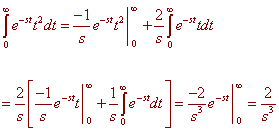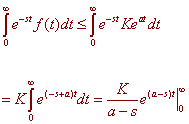The Laplace Transform
We have seen many techniques of solving differential equations that involve using a substitution. There is a special type of substitution, called an integral transform that simplifies the task of solving differential equations.
|
Definition of an Integral Transform Let K(s,t) be a function of two variables. The the Integral Transform with Kernel K, is defined as the mapping that takes functions to functions by the rule
|
Note: a and b can be any real numbers or even infinity or negative infinity
The most important integral transform in the field of differential equations is when a is 0, b is infinity, and K(s,t) is e-st.
|
Definition of the Laplace Transform
Let f(x) be a function. Then the Laplace Transform of f(x) is
|
Example
Find the Laplace Transform of f(x) = x2.
Solution
We just work out the integral
![]()
This can be worked out by integrating by parts twice.

We used the fact that
![]()
for all s > 0. This fact is easily proven using induction and LHopital's rule.
We can see that finding the Laplace transform of a function us just a matter of integration. We will usually see integration by parts enter into the picture.
Exercises
Find the Laplace transform of the following functions
A. f(x) = sin(at)
B. f(x) = cos(at)
C. f(x) = eat
D. f(x) = tn n a positive integer
E. f(x) = eat sin(bt)
Our next question to ask is when the Laplace transform of a function is defined. Since the Laplace transform of a function is defined as an improper integral, the integral may not converge. Fortunately most of the functions that we know and love have convergent Laplace transforms. More generally we have the following theorem.
| Theorem
Let f(t) be a piecewise continuous function on 0 < t < A for any A. Also let |f(t)| < Keat for all t > M with K, a and M real constants and K and M positive. Then the Laplace transform L{f(t)} = F(s) exists for s > a |
Proof
First, since f(t) is piecewise continuous, for large values of t, f(t) is continuous. Since convergence only depends on the behavior for large values of t, we can assume that f is continuous. To finish the proof we substitute the larger Keat for the smaller f(t) to get

This converges whenever a < s.
Another important fact about Laplace Transforms is that the Laplace transform is a linear transformation from "nice" functions to functions, where "nice" means functions that have a Laplace transform. That is,
L{f(t) + g(t)} = L{f(t)} + L{g(t)}
and
L{cf(t)} = cL{f(t)}
Back to the Power Series Methods and Laplace Transforms Home Page
Back to the Differential Equations Home Page
Back to the Math Department Home Page
e-mail Questions and Suggestions

